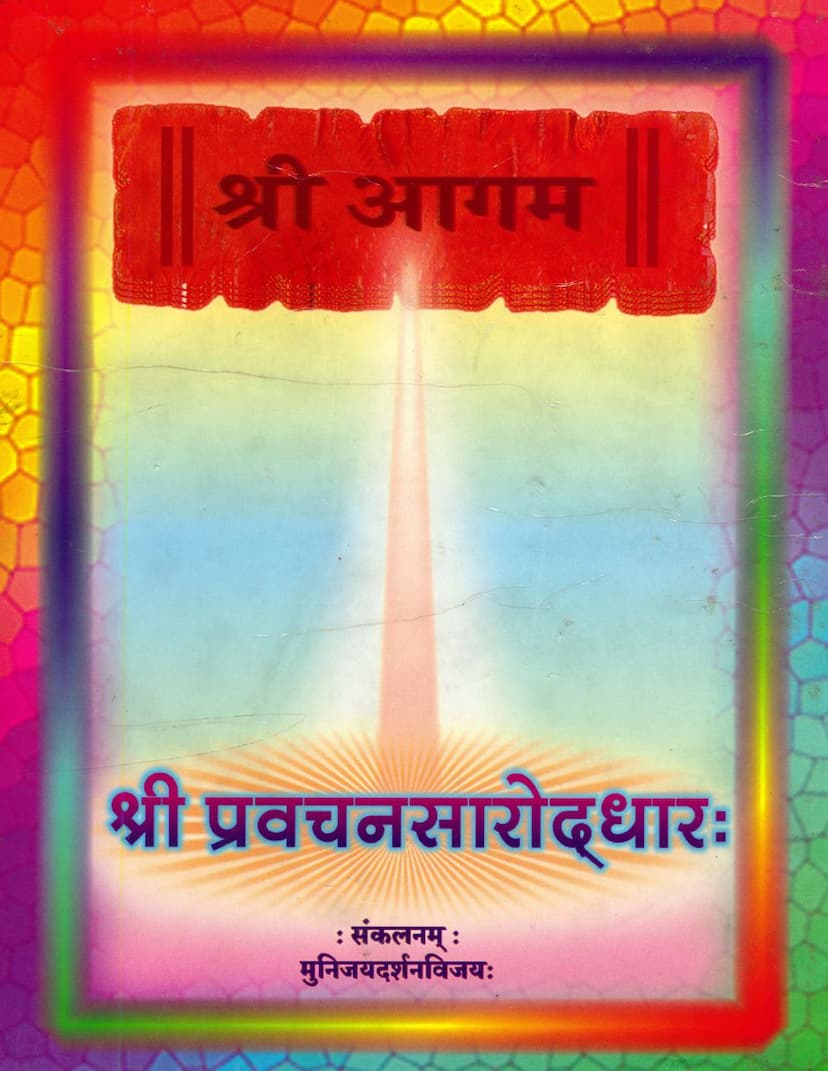Pravachan Saroddhar
Added to library: September 2, 2025

Summary
This is a comprehensive summary of the Jain text "Pravachan Saroddhar," compiled by Muni Jaydarshanvijay and published by Shri Jinagna Prakashan. The text is a collection of various philosophical and practical aspects of Jainism, drawing from the works of esteemed Acharyas like Shrimad Siddhasen Suri and Shrimad Nemichandra Suri.
The summary is organized based on the provided table of contents (विषयानुक्रमणिका), covering a wide range of topics essential to Jain philosophy and practice.
Key Areas Covered in the Summary:
-
Core Jain Practices and Rituals:
- Chaitravandan (चैत्यवंदन): The text details the veneration of Jin temples and idols.
- Guruvandan (गुरूवंदन): Emphasizes the importance of respecting and honoring spiritual preceptors.
- Pratikraman (प्रतिक्रमण): Covers the ritual of introspection and atonement for sins.
- Pratyakhyan (प्रत्याख्यान): Discusses the vows and renunciations taken by ascetics and lay followers.
- Kayotsarga (कायोत्सर्ग): Explains the practice of self-absorption and detachment from the body.
- Grihasthavrataatisara (गृहस्थव्रतातिचार): Addresses the specific transgressions related to the vows of householders.
-
Cosmology and Jain History:
- Names of Tirthankaras: Lists the names of Tirthankaras of Bharatavarsha and Airavatavarsha, both past and future.
- Prominent Figures: Mentions names of early Ganadharas and chief female ascetics (Pravartinis).
- Names of Parents: Enlists the names of the parents of Tirthankaras.
- Jina's Lineage: Details the lineage and birth details of Tirthankaras.
- Cosmic Geography: Mentions locations like Bharatavarsha, Airavatavarsha, and the cosmic divisions of the universe.
-
Spiritual Journey and Attainments:
- Gati (गति): Discusses the states of existence and transmigration of souls.
- Number of Souls: Provides statistics on the number of souls in different states and stages of spiritual development (monks, nuns, Kevalis, etc.).
- Siddha Moksha (सिद्ध मोक्ष): Elaborates on the nature, qualities, and characteristics of liberated souls (Siddhas), including their various classifications and dimensions.
- Spiritual Stages (Gunasthana): Covers the thirteen stages of spiritual progress.
- Practices for Liberation: Details various austerities (tapas) like knowledge austerity (ज्ञानतपः) and liberation austerity (निर्वाणतपः).
-
Jain Ethics and Conduct:
- Mahavratas (महाव्रत): Explains the five great vows of ascetics.
- Anuvaratas (अणुव्रत): Discusses the minor vows for lay followers.
- Practices for Ascetics and Laypeople: Covers rules of conduct, purification rituals, and daily routines.
- Types of Ascetics: Differentiates between various types of ascetics based on their practices and lineage.
- Defilements and Errors (Dosha, Asha-tana): Lists and explains various faults and violations of principles.
- Purity and Conduct (Samachari): Details rules and regulations for conduct.
-
Philosophical Concepts:
- Knowledge Types: Discusses different types of knowledge (Avadhi, Manahparyaya, Kevala Jnana).
- Karma Theory: Touches upon the principles of karma, including its binding, fruition, and emission.
- Cosmic Time Cycles: Explains the concepts of Utsarpini (ascending time cycle) and Avaparpini (descending time cycle).
- Soul and Non-Soul (Jiva-Ajiva): Touches upon the fundamental Jain ontological categories.
- Dravyas (Substances): Implies discussion on the Jain concept of six substances.
- Nayas (Modes of Understanding): Mentions the seven Nayas (logical standpoints).
-
Detailed Explanations:
- The summary indicates that the text goes into significant detail on each topic, such as:
- Aupadhian (उपकरण): Detailed descriptions of the possessions of ascetics, including specifics about clothing, utensils, and their measurements.
- Vastra Grahana Vidhi (वस्त्रग्रहणविधि): Rules for wearing clothes.
- Nishi Jagaran Vidhi (निशि जागरणविधि): Rules for staying awake at night.
- Alochana Dayaka Anveshana (आलोचनादायकान्वेषणा): The search for a suitable person for confession.
- Acharyadi Pratijagaran (आचार्यादि प्रतिजागरण): Rules for staying awake in the presence of elders.
- Upadhi Kshalana Kala (उपधिक्षालनकाल): The time for washing ascetic possessions.
- Bhojana Bhaga (भोजनभागा): Portions of food.
- Vasati Grahana Vidhi (वसतिग्रहणविधि): Rules for accepting a dwelling.
- Samlekhana Vidhi (संलेखनाविधि): The ritual of gradual self-starvation.
- Ushnodaka Kala (उष्णोदककाल): The time for consuming hot water.
- Tanu (तनु): Body measurements.
- Lachana (लांछन): Symbols associated with Tirthankaras.
- Varna (वर्ण): Colors associated with spiritual states or beings.
- Vrataparivara (व्रतपरिवार): The entourage or followers associated with vows.
- Ashata-dasha Shelaṅga Sahasra (अष्टादश शीलाङ्ग सहस्राणि): Elaborate lists related to virtues and practices.
- Parishaha (परिषह): The eighteen hardships to be endured by ascetics.
- Kshapaka Shreni & Upashama Shreni (क्षपकश्रेणिः, उपशमश्रेणिः): Detailed explanations of the stages of karma destruction and subsidence.
- The summary indicates that the text goes into significant detail on each topic, such as:
In essence, "Pravachan Saroddhar" is presented as a foundational text that systematically compiles and clarifies the vast knowledge and practices of Jainism, making it accessible for understanding and practice. The compiler, Muni Jaydarshanvijay, has organized this extensive knowledge in a structured manner, covering a multitude of aspects crucial for a comprehensive study of the Jain path to liberation.